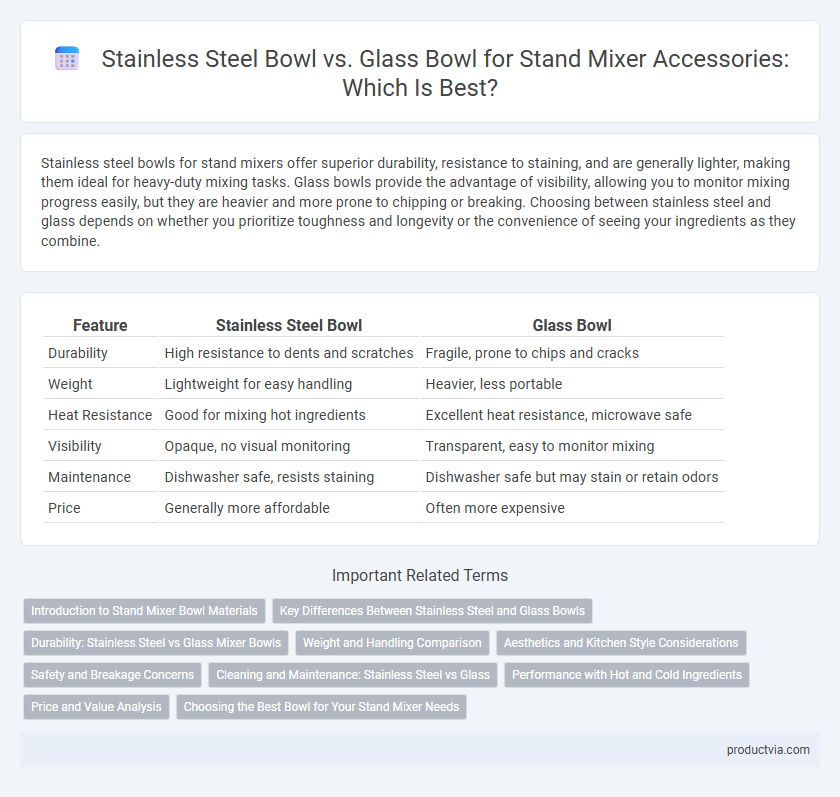Stainless steel bowls for stand mixers offer superior durability, resistance to staining, and are generally lighter, making them ideal for heavy-duty mixing tasks. Glass bowls provide the advantage of visibility, allowing you to monitor mixing progress easily, but they are heavier and more prone to chipping or breaking. Choosing between stainless steel and glass depends on whether you prioritize toughness and longevity or the convenience of seeing your ingredients as they combine.
Table of Comparison
| Feature | Stainless Steel Bowl | Glass Bowl |
|---|---|---|
| Durability | High resistance to dents and scratches | Fragile, prone to chips and cracks |
| Weight | Lightweight for easy handling | Heavier, less portable |
| Heat Resistance | Good for mixing hot ingredients | Excellent heat resistance, microwave safe |
| Visibility | Opaque, no visual monitoring | Transparent, easy to monitor mixing |
| Maintenance | Dishwasher safe, resists staining | Dishwasher safe but may stain or retain odors |
| Price | Generally more affordable | Often more expensive |
Introduction to Stand Mixer Bowl Materials
Stand mixer bowls are commonly made from stainless steel or glass, each offering distinct benefits for mixing tasks. Stainless steel bowls provide durability, resistance to stains and odors, and are typically lighter and less prone to breakage, making them ideal for heavy-duty mixing. Glass bowls allow users to easily monitor ingredient blending and are microwave-safe, but they tend to be heavier and more fragile compared to stainless steel options.
Key Differences Between Stainless Steel and Glass Bowls
Stainless steel bowls offer superior durability and resistance to dents, scratches, and stains, making them ideal for heavy-duty mixing tasks, while glass bowls provide the advantage of being non-reactive and allowing users to monitor mixing progress visually. Stainless steel bowls typically have better heat retention and are compatible with induction cooktops, whereas glass bowls are microwave-safe, making them versatile for melting and heating ingredients directly. Weight is another key difference, with glass bowls being heavier and potentially less comfortable for frequent handling compared to the lightweight stainless steel alternative.
Durability: Stainless Steel vs Glass Mixer Bowls
Stainless steel bowls for stand mixers offer superior durability due to their resistance to dents, scratches, and breakage, making them ideal for heavy-duty mixing tasks. Glass bowls, while visually appealing and allowing easy monitoring of ingredients, are more prone to chips, cracks, and breaking under impact or sudden temperature changes. Choosing stainless steel enhances longevity and reliability, especially for frequent or intense baking routines.
Weight and Handling Comparison
Stainless steel bowls for stand mixers are typically lighter than glass bowls, enhancing ease of handling during use and cleaning. Their lighter weight reduces strain when lifting or attaching to the mixer, making them preferred for frequent or heavy-duty mixing tasks. Glass bowls, being heavier and more fragile, require careful handling and are generally less convenient for rapid or repetitive kitchen work.
Aesthetics and Kitchen Style Considerations
Stainless steel bowls offer a sleek, modern look that complements contemporary kitchen designs and reflect light to enhance overall aesthetics. Glass bowls provide a clear, classic appearance ideal for traditional or farmhouse-style kitchens, allowing visual monitoring of ingredients during mixing. Choosing between stainless steel and glass bowls depends on matching the bowl's finish with kitchen decor elements such as cabinetry and countertops to create cohesive style harmony.
Safety and Breakage Concerns
Stainless steel bowls for stand mixers offer superior durability and resistance to breakage, making them a safer choice in busy kitchens where drops or impacts can occur. Glass bowls, while visually appealing and allowing users to monitor mixing progress, are prone to cracking or shattering under sudden temperature changes or accidental drops. Choosing stainless steel reduces the risk of injury from broken shards and ensures long-term safety and reliability during mixing tasks.
Cleaning and Maintenance: Stainless Steel vs Glass
Stainless steel bowls for stand mixers offer superior durability and resistance to stains and odors, making them easier to clean and maintain over time compared to glass bowls. Glass bowls may retain food residues and are more prone to chipping or cracking, requiring careful handling and more frequent cleaning. Both materials are dishwasher-safe, but stainless steel bowls typically provide a more hygienic and long-lasting option for regular kitchen use.
Performance with Hot and Cold Ingredients
Stainless steel bowls excel in handling both hot and cold ingredients due to their excellent thermal conductivity and resistance to temperature changes, ensuring consistent mixing performance without risk of cracking. Glass bowls, while visually appealing and non-reactive, may not withstand rapid temperature fluctuations as effectively, posing the risk of breakage when exposed to hot ingredients. For stand mixer users who frequently work with varying temperatures, stainless steel bowls offer greater durability and optimal performance.
Price and Value Analysis
Stainless steel bowls for stand mixers typically offer greater durability and a higher price point compared to glass bowls, which are generally more affordable but prone to chipping and scratching. Stainless steel's superior heat resistance and non-reactive properties add value for frequent bakers, while glass bowls provide the advantage of visibility to monitor mixing progress. Buyers seeking long-term investment and multi-functionality often find stainless steel bowls deliver better overall value despite the initial cost difference.
Choosing the Best Bowl for Your Stand Mixer Needs
Stainless steel bowls for stand mixers offer superior durability, resistance to stains and odors, and often feature measurement markings for precise ingredient handling. Glass bowls provide the advantage of visibility to monitor mixing progress and are non-reactive, making them ideal for acidic ingredients. Prioritize stainless steel for heavy-duty mixing and longevity, while glass bowls suit delicate recipes requiring visual oversight and easy cleaning.
Stainless steel bowl vs Glass bowl for stand mixer accessories Infographic

 productvia.com
productvia.com